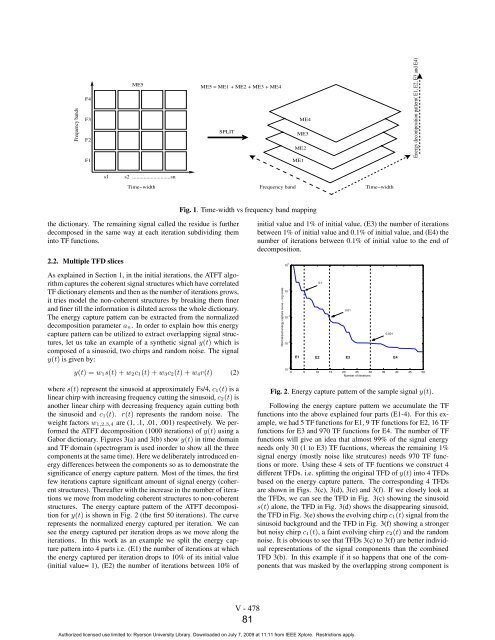Signal Analysis Research (SAR) Group - RNet - Ryerson University
Signal Analysis Research (SAR) Group - RNet - Ryerson University
Signal Analysis Research (SAR) Group - RNet - Ryerson University
You also want an ePaper? Increase the reach of your titles
YUMPU automatically turns print PDFs into web optimized ePapers that Google loves.
Frequency bands<br />
F4<br />
F3<br />
F2<br />
F1<br />
ME5<br />
s1 s2 ...........................sn<br />
Time−width<br />
ME5 = ME1 + ME2 + ME3 + ME4<br />
SPLIT<br />
the dictionary. The remaining signal called the residue is further<br />
decomposed in the same way at each iteration subdividing them<br />
into TF functions.<br />
2.2. Multiple TFD slices<br />
As explained in Section 1, in the initial iterations, the ATFT algorithm<br />
captures the coherent signal structures which have correlated<br />
TF dictionary elements and then as the number of iterations grows,<br />
it tries model the non-coherent structures by breaking them finer<br />
and finer till the information is diluted across the whole dictionary.<br />
The energy capture pattern can be extracted from the normalized<br />
decomposition parameter an. In order to explain how this energy<br />
capture pattern can be utilized to extract overlapping signal structures,<br />
let us take an example of a synthetic signal y(t) which is<br />
composed of a sinusoid, two chirps and random noise. The signal<br />
y(t) is given by:<br />
y(t) =w1s(t)+w2c1(t)+w3c2(t)+w4r(t) (2)<br />
where s(t) represent the sinusoid at approximately Fs/4, c1(t) is a<br />
linear chirp with increasing frequency cutting the sinusoid, c2(t) is<br />
another linear chirp with decreasing frequency again cutting both<br />
the sinusoid and c1(t). r(t) represents the random noise. The<br />
weight factors w1,2,3,4 are (1, .1, .01, .001) respectively. We performed<br />
the ATFT decomposition (1000 iterations) of y(t) using a<br />
Gabor dictionary. Figures 3(a) and 3(b) show y(t) in time domain<br />
and TF domain (spectrogram is used inorder to show all the three<br />
components at the same time). Here we deliberately introduced energy<br />
differences between the components so as to demonstrate the<br />
significance of energy capture pattern. Most of the times, the first<br />
few iterations capture significant amount of signal energy (coherent<br />
structures). Thereafter with the increase in the number of iterations<br />
we move from modeling coherent structures to non-coherent<br />
structures. The energy capture pattern of the ATFT decomposition<br />
for y(t) is shown in Fig. 2 (the first 50 iterations). The curve<br />
represents the normalized energy captured per iteration. We can<br />
see the energy captured per iteration drops as we move along the<br />
iterations. In this work as an example we split the energy capture<br />
pattern into 4 parts i.e. (E1) the number of iterations at which<br />
the energy captured per iteration drops to 10% of its initial value<br />
(initial value= 1), (E2) the number of iterations between 10% of<br />
Frequency band<br />
ME4<br />
ME3<br />
ME2<br />
ME1<br />
Fig. 1. Time-width vs frequency band mapping<br />
V - 478<br />
81<br />
Time−width<br />
initial value and 1% of initial value, (E3) the number of iterations<br />
between 1% of initial value and 0.1% of initial value, and (E4) the<br />
number of iterations between 0.1% of initial value to the end of<br />
decomposition.<br />
Normalized energy capture curve − log scale<br />
10 0<br />
10 −1<br />
10 −2<br />
10 −3<br />
0.1<br />
0.01<br />
0.001<br />
E1 E2 E3 E4<br />
Energy decomposition pattern( E1, E2, E3 and E4)<br />
10<br />
0 5 10 15 20 25 30 35 40 45 50<br />
−4<br />
Number of iterations<br />
Fig. 2. Energy capture pattern of the sample signal y(t).<br />
Following the energy capture pattern we accumulate the TF<br />
functions into the above explained four parts (E1-4). For this example,<br />
we had 5 TF functions for E1, 9 TF functions for E2, 16 TF<br />
functions for E3 and 970 TF functions for E4. The number of TF<br />
functions will give an idea that almost 99% of the signal energy<br />
needs only 30 (1 to E3) TF fucntions, whereas the remaining 1%<br />
signal energy (mostly noise like strutcures) needs 970 TF functions<br />
or more. Using these 4 sets of TF fucntions we construct 4<br />
different TFDs. i.e. splitting the original TFD of y(t) into 4 TFDs<br />
based on the energy capture pattern. The corresponding 4 TFDs<br />
are shown in Figs. 3(c), 3(d), 3(e) and 3(f). If we closely look at<br />
the TFDs, we can see the TFD in Fig. 3(c) showing the sinusoid<br />
s(t) alone, the TFD in Fig. 3(d) shows the disappearing sinusoid,<br />
the TFD in Fig. 3(e) shows the evolving chirp c1(t) signal from the<br />
sinusoid background and the TFD in Fig. 3(f) showing a stronger<br />
but noisy chirp c1(t), a faint evolving chirp c2(t) and the random<br />
noise. It is obvious to see that TFDs 3(c) to 3(f) are better individual<br />
representations of the signal components than the combined<br />
TFD 3(b). In this example if it so happens that one of the components<br />
that was masked by the overlapping strong component is<br />
Authorized licensed use limited to: <strong>Ryerson</strong> <strong>University</strong> Library. Downloaded on July 7, 2009 at 11:11 from IEEE Xplore. Restrictions apply.


